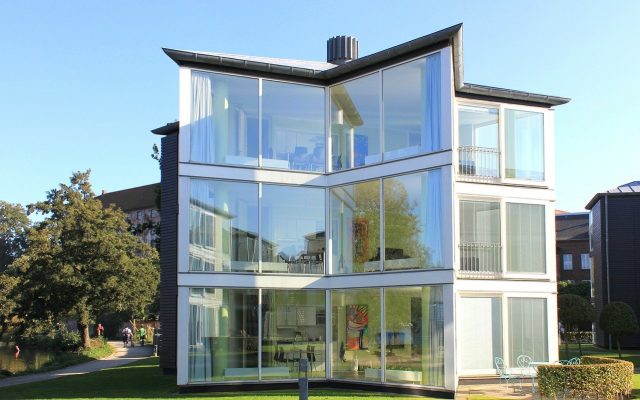
Glass has shaped architecture and design for centuries. Yet today, innovations in structural glazing technology are creating a seismic shift in spatial perceptions. Contemporary homes now integrate expansive transparent facades, walls of frameless glass, and floor-to-ceiling windows more seamlessly than ever before.
The upshot? Spectacular living environments flooded with natural light. Vast views stretch to the horizon from the comfort of your couch. This creates an immersive connection with the surrounding natural environs. Thanks to sophisticated building science and breakthroughs in structural glass engineering, visually astonishing yet pragmatic glazing implementations have become possible.
In 2024 and beyond, structural glazing unlocks the next frontier in the fluid integration of indoor comfort with outdoor living. An exciting possibility beckons – the potential dematerialization of barriers allowing broader vistas, daylight and ventilation. Some of the most innovative window designs we see today give us a sneak peek at what homes of the future might feel like. By using huge, frameless windows, architects are reimagining what it means to live comfortably in a dwelling, both indoors and out.
What is Structural Glazing?
Structural glazing is a type of architectural glass meant to handle weather and temperature shifts. It also gives insulation and keeps spaces airtight. In structural glazing, glass is bonded directly to the window frame. It uses super-strong adhesives or anchors instead of typical hardware.
This bonding technique gives structural glazing systems incredible strength and the ability to support heavier glass expanses with limited or no framing. The result is glass systems with unbroken sightlines that maximize light, space, and visual coherence.
Benefits of Structural Glazing
Some key benefits of incorporating structural glazing elements into home design include:
Natural Light Maximization
By reducing visual breaks caused by thick framing and mullions, structural glazing introduces more sunlight into interior living spaces. Rooms flooded with natural light evoke a soothing yet energizing ambience ideal for rest and recreation.
Energy Efficiency
Enhanced sightlines and the use of high-performance glass contribute to improved insulation efficiency. It decreases the need for artificial heating and cooling. Consequently, structural glazing not only reduces energy costs but also minimizes environmental impact.
Aesthetic Appeal
With frameless windows, glass floors and minimalist curtain walls, structural glazing adds an ethereal quality to living spaces. It does this by creating a visual link between the interiors and surrounding views. The resulting spaces provide a clean, contemporary backdrop for interior design exploration.
6 Best Structural Glazing Designs For Home
Here are the most popular structural glazing elements incorporated by homeowners in 2024:
1. Frameless Windows
Already gaining traction over traditional counterparts, advances in bonding techniques have further propelled frameless windows in contemporary residential projects.
Frameless windows create unobstructed outward views that visually expand interior spaces by eliminating thick chunks of framing and mullions that block light. The customizability of frameless systems in shape, size, and glass performance, enables tailored solutions to design aesthetics and performance needs.
2. Minimalist Glass Facades
A bold trend in modern architecture is full-height glass curtain walls. These walls create a sleek, minimalist building envelope that blurs the boundaries between a structure’s interior and exterior environments.
Apart from incredible aesthetic appeal, high-performance glass minimizes solar heat gain while providing opaque views out and daylighting inwards. Additionally, automated privacy screens or smart glass technology offer solar shading and privacy control options.
3. Curved Glass Structures
Once considered complex and prohibitive, curved glass structures have entered the residential mainstream. This is thanks to advances in cold-bending glass technology and structural silicone glazing techniques.
With incredible strength, versatility and variety, curved glass imparts softness to minimalist designs. Used in walls, roofs, canopies or staircases, curved glass introduces sweeping lines which expand perceived space.
4. Oriel Windows
A classic feature of Gothic architecture is now re-imagined with contemporary materials like frameless glass and metals. Oriel windows dynamically cantilever over exterior walls instead of being set flush within them. This protrusion coupled with expansive glazing draws abundant natural light deeper into interior rooms.
Inward-opening casements also facilitate cross ventilation while providing additional weather protection to underlying spaces. Moreover, Oriel windows impart spatial diversity within consistent architectural language.
5. Smart Glass Solutions
Advances in electrochromic tech enabling user-controlled light transmission through electric signals have brought smart glass into contemporary residential projects. Switchable glass can alternate between highly transparent to various tinted stages – providing adjustable daylight, glare control and privacy with the flick of a switch.
Integrating automation and IoT further enhances functionality. This includes automated shading responses based on climatic conditions along with security enhancements through remote monitoring apps.
6. Frameless Glass Walls
The ultimate realization of indoor/outdoor spatial fluidity, frameless glass walls with minimalist structural supports. These elements create airy, crystalline interiors washed in natural light. This effect is further enhanced by high-strength structural silicone bonding. It, along with laminated glass, enhances structural performance for entire facades up to 4 stories tall.
Various performance glass options including solar control, low-E, switchable, electrochromic or even luminescent provide optimal comfort and functionality. Combined with retractable screens or dynamic solar shading systems, frameless glass walls enable spaces attuned to personal comfort & contextual environment.
Choosing the Right Glazing Design for Your Home
The range of available structural glazing options means homeowners are spoiled for choice. However, variety can also induce decision paralysis. By focusing on key considerations impacting functionality and living quality, you can zero in on solutions aligned with your priorities.
Climate:
As the interface between indoor and outdoor, glazing plays a frontline role in moderating climatic impacts on building interiors. Therefore, consider local climate patterns when selecting glass performance traits like solar heat control, insulation, light transmittance, and air tightness. In regions where extreme cold, heat, or sunlight are factors, specialized glass coatings, tints, and deferred assembly techniques can significantly boost occupant comfort.
Incorporating automated shading systems and smart glass technologies enhances climate attunement. These systems are tuned to ambient conditions through sensors and positional tracking. This allows for dynamic adjustments based on real-time data. For example, outdoor sensors can trigger internal roller shades to deploy on hot sunny days. They can also retract during cooler overcast periods to maximize natural light permeation.
Architecture:
The angles, sizes, sightlines, and transparency qualities of the glazing components should align with the building’s overall architectural language. This ensures a cohesive aesthetic throughout the structure. Sympathetic proportions and material finishes prevent disjointed visual tension.
For heritage sites or period designs, frameless glass inserts can put a contemporary twist on original architectural detailing. However, where more striking juxtapositions are intended, bolder shapes and sizes interject modernist flair. The key is maintaining contextual relevance.
Personal Preferences:
Analyze how your household utilizes interior spaces and connect glazing selection to personalized priorities. This involves considering lighting needs, privacy preferences, energy consumption patterns, and how different spaces are used during the day and night. By factoring in user insights, you can prevent inefficient generalisations.
For instance, bedroom windows would prioritize softer lighting and blackout capabilities as well as noise insulation. On the other hand, living rooms may emphasize transparent outlooks and solar gain during colder months. Optimized glazing unlocks bespoke spatial functionality, tailored to the specific needs of each room.
Conclusion:
As the conversation around sustainable design grows worldwide, structural glazing ticks several key boxes. Instead of bulkier buildings, it allows for spatial richness through minimalist, frameless designs. It also promotes well-being by letting in more natural light and passive climate control. Additionally, structural glazing improves the environmental performance of buildings over their full life span.
With frameless glass, the barriers to open views are eliminated. This allows the beautiful qualities of the outdoors to flow into interior spaces. Technological innovation has paved the way for dramatic shifts in architectural perceptions and possibilities. By taking a more informed approach, homeowners can intelligently adopt glazing designs that merge visual delight with functional performance – resulting in living environments that nurture personal and social well-being.
It is an exciting frontier for home spaces in 2024. Minimal framing, incredible views, expanded volumes, sustainable comfort – structural glazing unlocks it all and more!













